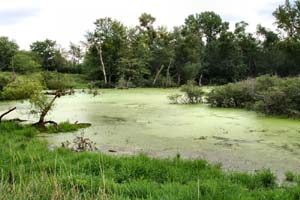 NEWS NEWS
|
|
Previous Article
Half of world's wetlands lost already: Experts
Parvinder Singh
Source: Toxics Link, Date: , 2007
A half-day workshop was organised in the National Capital's National Science Centre to observe the World Wetland Day on 2 February by the Ministry of Environment and Forests and The Energy Research Institute for highlighting their ecological importance, the threat they face today and ways to protect them.
Experts and senior government officials shared platform to highlight the importance of these niche ecosystems, which are being rapidly lost due to population pressure and indiscriminate exploitation. The day went unnoticed by the mainstream media clearly highlighted the lack of awareness and concern over the role of the wetlands play in maintaining bio-diversity and hydrological balance, besides providing subsistence to a large population across varied geographical regions.
 Not appreciated much by the modern society, most of these ecosystems have been dried-up and reclaimed for fulfilling an insatiable demand for land. According to one estimate 50 per cent of the world's wetlands have already been lost. Not appreciated much by the modern society, most of these ecosystems have been dried-up and reclaimed for fulfilling an insatiable demand for land. According to one estimate 50 per cent of the world's wetlands have already been lost.
Ecologically, wetlands are integral to a healthy environment. They retain water during dry periods, thus keeping the water table stable. During flooding, they act as a buffer and reduce damage by the force rising water. They trap suspended solids and nutrients thus making them available to various organisms and species.
As with any natural habitat, wetlands are important in supporting species diversity and have a complex and important food web. The recent millennium assessment of ecosystems puts freshwater biodiversity as the most threatened of all types of biodiversity.
Prof C. K. Varshney, Jawaharlal Nehru University, in his in-depth presentation on the role of wetlands and need for their conservation, stated that the wetlands are the most productive ecosystems on the planet. Regardless of their size, they are critical to communities living around them. Exotic preservation of these systems by the way of keeping only a few intact or restoring them would not fully address the issue of the damage being caused by their loss.
Highlighting the correlation between the wetlands and the support they provide to communities through fish and other marine products, he said these are decentralised water storage systems that allow people to maintain their subsistence over a very long span of time. However, their value, he added, also needs to be assessed in terms of the role they play in shaping the social and cultural milieu of a particular community.
For a country like India, with its vast biological and cultural diversity, a comprehensive use of remote sensing, GIS and other related technologies would have to be employed for gathering vital information on there current status and the role they play in the local and larger environment. Classifying and mapping wetlands based on geomorphology, water quality and other biological attribute can lead to qualitative assessment. Results obtained could be used in planning, inventorying and monitoring wetlands in the country.
The Ramsar Convention is an international treaty for the conservation and sustainable utilisation of wetlands, and to stem the progressive encroachment on them and loss of wetlands, now and in the future, recognising the fundamental ecological functions of wetlands and their economic, cultural, scientific, and recreational value. The convention was developed and adopted by participating nations at a meeting in Ramsar, Iran on February 2, 1971 and came into force on December 21, 1975.
India has 19 wetland areas listed as Ramsar Sites. These are: Chilika Lake, Orissa, Keoladeo National Park, Rajasthan, Wular Lake, Jammu and Kashmir, Harike Lake, Punjab, Loktak Lake, Manipur, Sambhar Lake, Rajasthan, Kanjli, Punjab, Ropar, Punjab, Ashtamudi Wetland, Kerala, Bhitarkanika Mangroves, Orissa, Bhoj Wetland, Madhya Pradesh, Deepor Beel, Assam, East Calcutta Wetlands, West Bengal, Kolleru Lake, Andhra Pradesh, Point Calimere Wildlife and Bird Sanctuary, Tamil Nadu, Pong Dam Lake, Himachal Pradesh, Sasthamkotta Lake, Kerala, Tsomoriri, Jammu and Kashmir and Vembanad-Kol Wetland, Kerala. Previous Article
|
|


 Not appreciated much by the modern society, most of these ecosystems have been dried-up and reclaimed for fulfilling an insatiable demand for land. According to one estimate 50 per cent of the world's wetlands have already been lost.
Not appreciated much by the modern society, most of these ecosystems have been dried-up and reclaimed for fulfilling an insatiable demand for land. According to one estimate 50 per cent of the world's wetlands have already been lost.